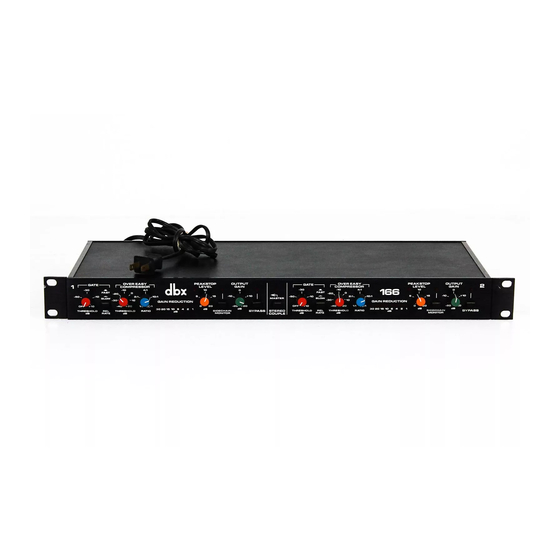dbx 166 Manual de inicio rápido - Página 11
Navegue en línea o descargue pdf Manual de inicio rápido para Hardware informático dbx 166. dbx 166 18 páginas. Professional dynamics processor
También para dbx 166: Manual rápido (17 páginas)

Preventing tape
saturation
A
high threshold (but
below
tape
saturation)
and
high
compression
ratio
will
cause
the
compressor
to
reduce
gain
in
a
controlled
manner
before the tape overloads and
distorts.
Speaker
protection
and
acoustical
distribution
Compression
will
keep
excessive
levels
from damaging
drivers
in
sound-reinforce-
ment
systems. Limiting
also
enhances
intelligibility
by
letting
low-level material
be
reproduced throughout the house
at higher
volumes;
in
a performance,
this
increases
intimacy, as whispers
become
clear at
virtually
every
seat.
Our OverEasy
characteristic
permits
high
amounts
of
compression
(e.g.,
iO:l)
to
be
used without
vocalists or
musicians
feeling
choked back
—
and with
high
average
levels
maintained without speaker
damage
due
to
heat buiidup
in
the
drivers.
As
a
rule,
to give
tiie
best protection, your
1
66 should
be
as close as possible
in
the
signal
path to the
power amp. For
maximum
SPLs,
large
sound-reinforcement systems
frequently
have a
separate
compressor on each
output
of
the
electronic
crossover's).
Where
the 166
will
be expected
to
allow
virtually
no
level
change
unless
an
emer-
gency
(wildly
excessive
levels) arises,
set
the
ratio to Infinityti
and
the Threshold
to the
highest
level.
OverEasy
will
never
act
in
the
fast,
unpleasant
manner
of
a
typical
"hard-
knee" compressor, but
it
will
give
a
measure
of real protection.
See the next
section,
too.
ABOUT
LIMITING
and
SOFT
CLIPPING
PeakStop
ediows
you
to
control the
maximum
peak
levels at
the output
of the
1
66
irrespective of
any
other
control.
As
mentioned,
it
comes
after
the compression and
other
circuitry,
including the
output
gain,
so
it
lets
an absolute
limit
be put on the peak-
to^>eak excursions
of
the
output.
PeakStop works
instantaneously;
you'll
be
able to apply
moderate amounts
of
compression and
still
be
independently protected
from
large trans-
ients,
other short-term overloads,
and
broadcast overmodulation.
PeakStop cwsists
of
a
sophisticated voltage-controlled clipper that
produces a
minimum
of audible
distortion.
It
rounds the
comers
of
a peak
rather
than
cutting
it
off
sharply, as
the
term
"clipping" implies.
By making a
signal's
leading
and
trailing
edges
curves
instead of
sharp
corners,
it
reduces the
amount
of higher-order,
offensive-sounding
harmonics
that
conventional
clipping causes.
The
level at
which PeakStop
is
activated
is
adjustable
from
0 to
+20 dBv.
Note
that small
signal
excursions
above
the
s^
value
of
PeakStop
are
possible,
to allow
the rounding
to take place. Therefore,
for
any
applica-
tions
where
you
must
not
exceed a
given
ceiling, set
the
PeakStop
control 1-2
dB
below
it
to
be
sure.
The PeakStop
LED
flashes
whenever
peaks
attempt
to
exceed
the
PeakStop
level
and
get
reduced
in
amplitude.
To
disable
the function altogether, simply
set
the
control
to
+20 (which
is
the
maximum
output
level of
the 166 anyway).
In
use,
the
PeakStop
function
can
prevent an
amplifier
from
being driven
into
hard
clipping,
where
it
may
lose
control over the
speaker system.
PeakStop
Is
a smooth,
well-
controlled clipper
whose
behavior
is
s<micaiiy similar to
the gentleness
of
OverEasy
com-
pression;
its
clipping
is
much
preferable
to
a
power
amp's.
As
noted, control of
speaker
overexcursion,
of
broadcast overmodulation,
and
of harsh electronics clipping are
all
applications;
with
PeakStop and
OverEcisy,
you have
the best of both worlds:
virtually
inaudible
rms compression and peak
protection
downstream,
at
the
end.
-
9
-
